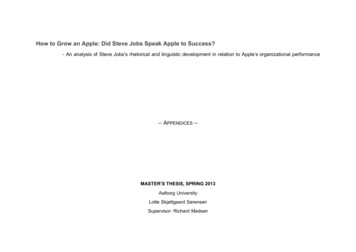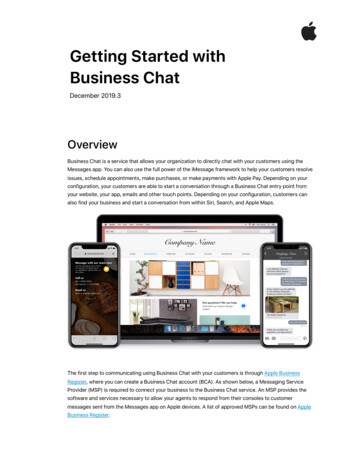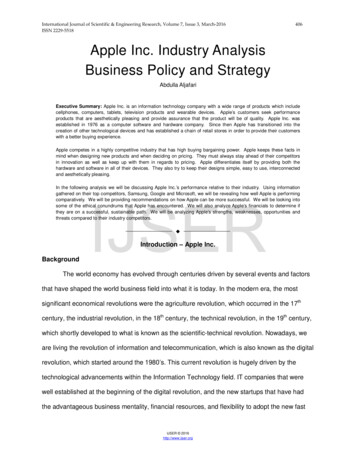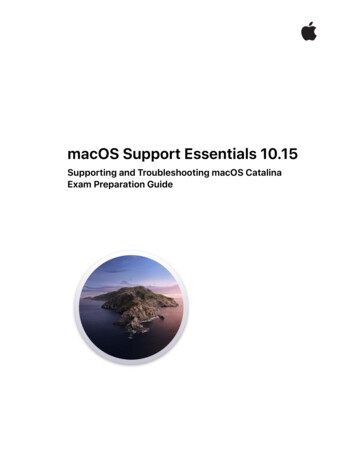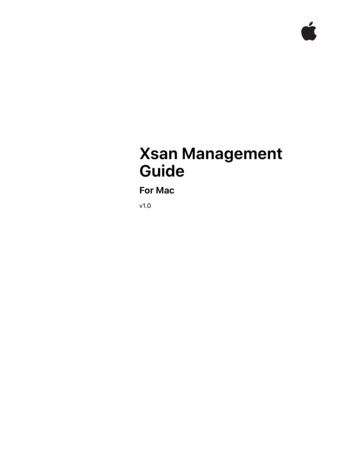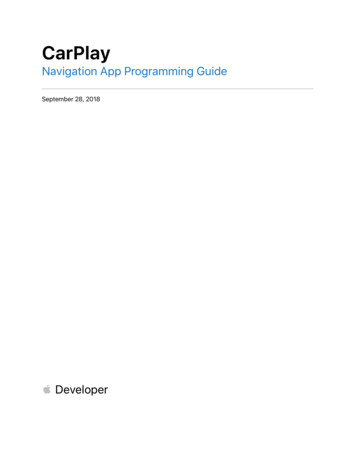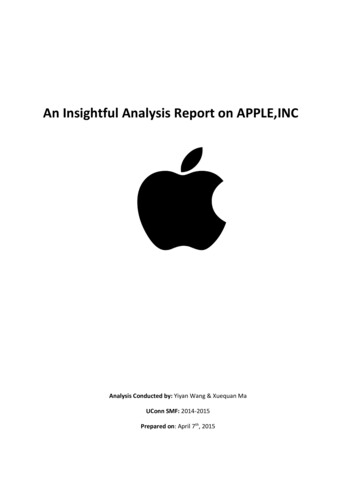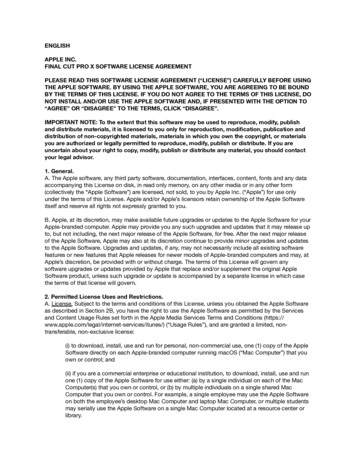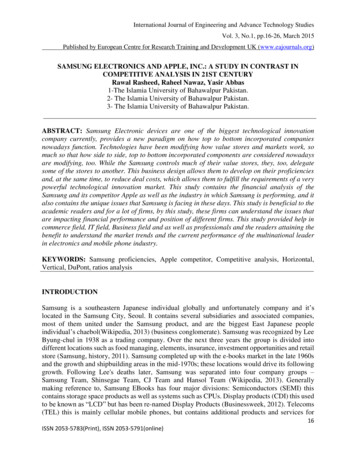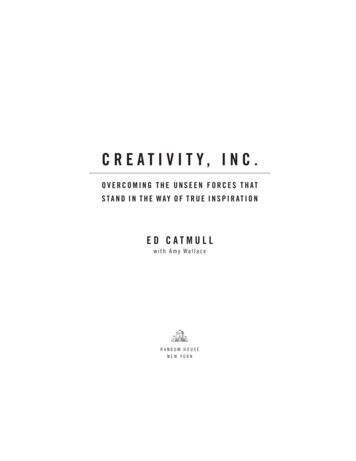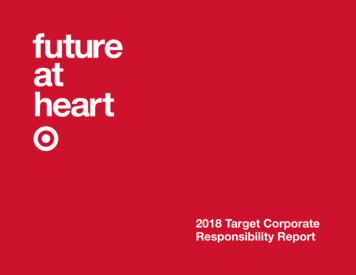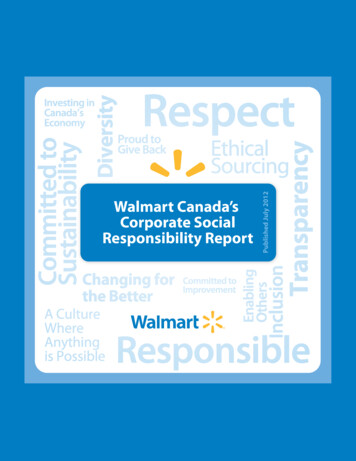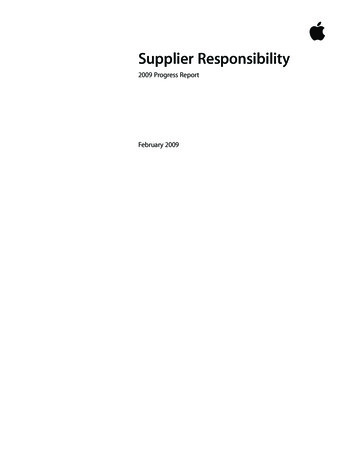
Transcription
Supplier Responsibility2009 Progress ReportFebruary 2009
Supplier Responsibility2009 Progress ReportContentsPage 3Executive SummaryApple and Supplier ResponsibilitySetting Clear Expectations2008 Program HighlightsPage 5Monitoring ComplianceThe Audit ProcessThe Corrective Action ProcessPage 6Audit ResultsCore Violations and Corrective ActionsCompliance OverviewManagement SystemsPage 12Continuous ImprovementRepeat Audits Show ProgressWorker TrainingPage 14Integration into Apple BusinessAccountability Through Business ReviewsEducating and Empowering Apple EmployeesPage 15Supplier Employee Education and DevelopmentPage 16Supplier Code of Conduct Revisions2
Supplier Responsibility2009 Progress Report3Executive SummaryApple and Supplier ResponsibilityApple is committed to ensuring the highest standards of social responsibilitythroughout our supply chain. The companies we do business with must providesafe working conditions, treat employees with dignity and respect, and use environmentally responsible manufacturing processes wherever Apple products are made.For the past several years, Apple has required suppliers to commit to a comprehensiveSupplier Code of Conduct as a condition of their contracts with us. We drive complianceto the Code through an aggressive monitoring program, including factory audits,corrective action plans, and verification measures.Apple’s approach to supplier responsibility extends beyond compliance monitoring.We also provide detailed standards and ongoing training support to help supplierscontinue to meet our expectations. And by making social responsibility part of theway we do business, we ensure that suppliers take our standards as seriously as we do.CustomerApple Supplier Code of ConductAppleFinal AssemblyManufacturersComponentSuppliersApple products and components are manufactured by a wide variety of suppliers around the world.The final assembly of most products occurs in China.
Supplier Responsibility2009 Progress Report4Setting Clear ExpectationsThe Apple Supplier Code of Conduct outlines a comprehensive set of expectationscovering labor, human rights, the environment, health and safety, ethics, andmanagement systems. Every Apple supplier contract includes a commitment tocomply with the Code.Our Supplier Code of Conduct draws on internationally recognized standards. Whilesimilar to the Electronics Industry Citizenship Coalition (EICC) Code of Conduct, itis more stringent in several important areas. For example, Apple’s Code includesconcepts from the International Labor Organization (ILO) conventions regarding therights of workers to freely associate and bargain collectively. Our Code also prohibitsdiscrimination based on pregnancy test results.As in previous years, we’ve continued to strengthen the Apple Supplier Code ofConduct based on our audit experience and input from stakeholders. Our recentupdates make the Code even more protective of the workers in our supply chainand further clarify our expectations.To download the Apple Supplier Code of Conduct, visit www.apple.com/supplierresponsibility.2008 Program HighlightsIn 2008, we extended and enhanced our supplier responsibility programs.AuditedAudited Facilities398320072008 We more than doubled the number of facilities audited for compliance with our Code,completing onsite audits of 83 facilities in 2008, compared with 39 facilities in 2007. We implemented more rigorous investigation methods and enhanced our remediationprocedure for core violations. In addition, we instituted a more thorough procedure forverifying corrective actions resulting from an audit. We developed an industry-leading position on recruitment practices in response to anaudit discovery involving immigrating workers. We learned that some of our suppliershad hired contract workers from one country to work in factories in another countryand that some of those workers had paid recruitment fees in excess of applicable legallimits. In addition to demanding reimbursement, we updated our Code to require thatsuppliers take responsibility for the entire recruitment process, including the recruitmentpractices and fees of labor agencies in the workers’ home countries. We expanded our efforts with our suppliers to train workers on their rights and totrain management and supervisors on their social responsibility obligations. In partnership with our suppliers, more than 27,000 people were trained in 2008, up from2200 people in 2007. In 2008, we trained more than 400 Apple employees, empowering them to monitorcompliance to our Code whenever they visit supplier facilities. We launched an education and development pilot at one of our supplier’s factories tohelp workers fulfill their educational aspirations while continuing their employment.This report provides more information about specific findings and corrective actionsfrom our 2008 audits, as well as a description of program enhancements designed todrive further improvements.
Supplier Responsibility2009 Progress Report5Monitoring ComplianceThe Audit ProcessOur compliance program begins with a risk assessment that considers the locationof the factory, the level of business involvement with Apple, and past audit performance—including corrective action closure and management’s commitmentto improvement.Protection Against RetaliationWhen we interview workers, we ask them tovoluntarily provide their contact information.We follow up after the audit with those workerswho share this information to ensure they havenot been subjected to any retaliation or harshtreatment as a result of their participation.When Apple audits a supplier, our employees take the lead—with the support ofin-region staff and third-party experts who know the language and understand localregulations and practices. Each of the auditors on the team is trained to use ourdetailed protocol and to assess every item across all 17 categories in our Code. Evenif no violation is found, we evaluate the management system for each element of ourCode and identify areas for improvement.Apple procurement managers help coordinate the audit, while serving as an escalationpoint for any issues that arise during the audit and corrective action process. This directinvolvement makes it clear to our suppliers that social responsibility is integral to theirbusiness relationship with Apple.The audit includes: Confidential interviews with randomly selected employees from the line, representingmultiple shifts and both direct and contract workers Interviews with senior management in all major functional areas Physical inspections of manufacturing facilities and, as appropriate, living anddining areas Review of records and relevant policies and proceduresThe Corrective Action ProcessAt the conclusion of the audit, the audit team reviews the findings with the facilitymanagement, and the factory’s most senior manager provides written acknowledgement of the preliminary audit findings.When improvements are needed, Apple requires the supplier to produce a correctiveaction plan that addresses not only the specific violation, but also the underlyingmanagement system needed to prevent reoccurrence. We track completion of eachcorrective action to closure, with an expectation that all violations will be correctedas quickly as possible, but not later than 90 days after the audit.To confirm that corrective actions have been closed to Apple’s satisfaction, our teamperforms a Corrective Action Verification audit. If we find issues that have beeninadequately addressed, we continue to work with the supplier on additional improvement measures. However, where violations are numerous or severe and correctiveactions are inadequate, we terminate the business relationship.
Supplier Responsibility2009 Progress Report6Audit ResultsIn 2008, we continued to expand the scope of our compliance program. We completedonsite audits at 83 facilities, including 10 repeat audits and 73 first-time audits selectedthrough a risk management process. Our return visits revealed continued performanceimprovements and better working conditions, with overall compliance increasing atevery facility. First-time audits revealed patterns of compliance and noncompliancesimilar to our first-time audits in 2007.Our most significant discovery involved recruitment practices in which our suppliershad hired workers from one country to work in factories in another country. Of the83 facilities audited, we found six facilities where these contract workers stated theyhad paid recruitment fees that exceeded the applicable legal limits—often requiringthem or their families to incur a debt. We classified this overcharge as a core violation,our most serious category of violation, since these workers may not feel at liberty toleave employment until the debt is paid.Other core violations included one case of coaching workers interviewed in the auditprocess, seven cases of underage workers, and three cases of falsified records.Core Violations and Corrective Actions97%Compliant3%Core ViolationsDetectedNinety-seven percent of the core issuesassessed by our auditors were in compliance.A core violation is the most serious class of violation, as it refers to any practice orsituation that Apple believes to be contrary to our core principles. Instances of abuse,underage labor, involuntary labor, falsification of audited materials, significant threats toemployee safety, and any intimidation or retaliation against workers participating in anaudit are classified as core violations.When a core violation is detected, we require that the supplier remedy the situationimmediately according to a specific action plan approved by Apple. In addition, thesupplier is placed on probation for one year, during which time they remain undergreater scrutiny from Apple and are at higher risk of losing future business. Discoveryof a core violation also increases the frequency of repeat audits of the facility.Recruitment fee overchargesApple’s audits revealed a complex labor supply chain, whose recruitment practicesmay result in worker-paid fees in excess of applicable legal limits. Upon investigation,we learned that some of our suppliers work with third-party labor agencies tosource workers from other countries. These agencies, in turn, work through multiplesubagencies—both in the hiring country and the workers’ home country—in somecases, all the way back to recruiters in the worker’s home village. By the time the workerhas paid each agency, the total fees may be equivalent to many months’ wages andexceed legal limits.
Supplier Responsibility2009 Progress Report7Apple discovered six facilities where foreign workers stated that they had paid agencyrecruitment fees in excess of the applicable legal limits—and may have needed to incurdebt to pay these fees. In many instances, the workers felt they had no choice but towork off the debt. Apple’s Code has always strictly prohibited all forms of involuntarylabor, and we classify these cases as core violations of voluntary labor rights.Interviews with contract workersApple’s rigorous audit process includesinterviews with contract workers—notjust with supplier’s employees, as is morecommonly the case. When foreign contractworkers are employed at an audited facility,we hire translators who speak their nativelanguage to ensure that interviews arefully understood.In each of the six facilities, we brought in an industry expert to conduct a detailed investigation of the recruitment process, comparing the fees paid by workers against the legallimits in the country of origin and in the hiring country. We are requiring each supplierto reimburse any fees that exceed these limits. To date, our suppliers have agreed toreimburse workers 852,000 in recruitment fee overcharges.We also discovered that one supplier had required foreign workers to submit their passports for safekeeping, which limited workers’ access to their papers. We demanded thatthe supplier return the passports to the workers. In situations where it is advisable for thesupplier to hold passports for safekeeping, we require a process that allows workers freeaccess to their documents and informs them in their native language of their access rights.To prevent future abuses of this nature, Apple holds our suppliers responsible for therecruitment practices of their labor agencies and the entire recruitment supply chain—requiring them to limit worker-paid fees to the equivalent of one month’s net wages. Inaddition, we require our suppliers to audit and manage the recruitment suppliers withthe same rigor as they manage their manufacturing suppliers. To clarify these requirements, we have updated our Code and developed a new Prevention of InvoluntaryLabor standard.CoachingIn one of the recruitment fee overcharge cases, we discovered that foreign workershad been coached prior to our interviews. This coaching was classified as an additionalcore violation. We immediately met with the company’s senior management to addressthe specific issue and to develop a plan to correct the underlying management systems.We required the facility to install a hotline where workers can anonymously reportgrievances directly to Apple. We review this anonymous feedback with the factorymanagement and demand corrective actions. Since many of the grievances were relatedto supervisor behavior and management communication, we required the facility todevelop and deliver appropriate supervisor training and to institute new systems thatimprove worker-management communication. Subsequent feedback from the workersabout the conditions at this facility has dramatically improved.Underage laborOf the 83 facilities audited, Apple discovered seven facilities that had hired 15-year-oldworkers in areas where the minimum age for employment is 16. Across the seven facilities, a total of 25 workers were hired before reaching the legal age.Nineteen of the 25 cases were historical incidents in which our auditors found records
gation of the recruitment process, comparing the fees paid by workers against the legal limits in the country of origin and in the hiring country. We are requiring each supplier to reimburse any fees that exceed these limits. To date, our suppliers have agreed to
